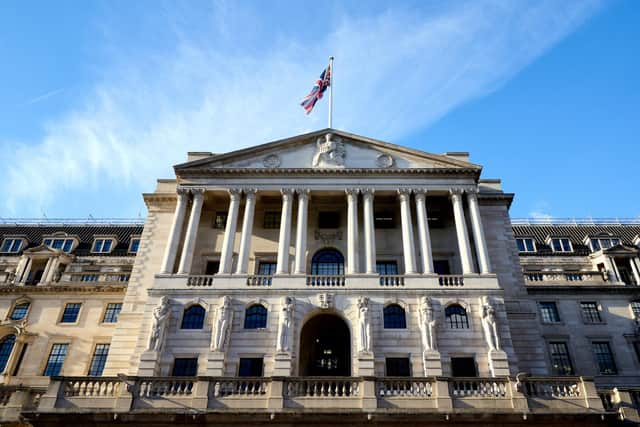Interest rates: Why the latest hike may not be an end to the pain
Rate-setters on the central bank’s nine-strong monetary policy committee (MPC) decided 7-2 to increase the base rate from 4 per cent to 4.25 per cent. It marked the 11th consecutive rise and came as little surprise after this week’s largely unexpected rebound in inflation. However, bank officials acknowledged the recent period of volatility in the global banking sector, after the collapse of US-based Silicon Valley Bank and the rescue takeover of Credit Suisse. It’s a tricky balancing act that also led to the Federal Reserve further hiking US rates on Wednesday night.
The Bank of England remains confident that consumer price inflation - which last month jumped to an annual rate of 10.4 per cent from 10.1 per cent - will fall sharply over the rest of the year. Chancellor Jeremy Hunt has pledged to halve inflation by the end of the year and the Office for Budget Responsibility reckons it could fall to as low as 2.9 per cent by that stage, though that would still be above the central bank’s 2 per cent long-term target.
Advertisement
Hide AdAdvertisement
Hide AdSusannah Streeter, head of money and markets at investment platform Hargreaves Lansdown, said the banking turmoil was likely to prompt a pause in rate hikes come May’s meeting, but further monetary tightening is still possible. “A banking curve ball has been thrown into the Bank of England’s already tricky juggling act, but for now the eye of policymakers is still firmly trained on catching inflation and bringing it under control,” she said. “The knock-on effects of the banking scare are still hard to determine, and with lending criteria expected to be tightened and loans set to be harder to come by, a forecast deterioration in financial conditions is likely to be the equivalent to further interest rate rises in the months to come. Inflation was already expected to drop sharply by the end of the year and if consumers and companies find it harder to access credit, it’s likely to be a fresh disinflationary force.”
The MPC said it would make a “full assessment” of recent banking woes and market volatility in its forecast in May, and that it was monitoring the situation closely. Thomas Pugh, economist at audit, tax and consulting firm RSM UK, believes that 4.25 per cent represents a peak for interest rates, but warned the risk remains that borrowing costs could “go higher before they go lower”.
He noted: “The MPC hinted that it might not be done with rate hikes after all. Indeed, whether the decision is another rate hike or a hold will depend on how the labour market evolves over the next few months. If the unemployment rate remains very low and wage growth shows little sign of coming down to the 3 per cent level the MPC thinks is consistent with 2 per cent inflation, then there is scope for further rises in interest rates in the summer.”
James Lynch, fixed income investment manager at Aegon Asset Management, said the subject of what areas were persistently inflationary was feeling “slightly more subjective” and cautioned that further tightening in monetary policy may be required. “The Bank maintains that if its base case prevails then no more hikes will be necessary, but it will do more if needed,” Lynch noted. “Of course, what is persistently inflationary now feels slightly more subjective, and it could use any data it pretty much wishes to justify hiking or not. It was interesting that Silicon Valley Bank was mentioned four times in the [Bank’s] minutes. Even though it acknowledged the soundness of the UK banking sector, there is a sense that it will now be looking for any second-round effects on the outlook for growth and inflation.”
David Alexander, chief executive officer of DJ Alexander Scotland, part of Lomond Group, the largest lettings and estate agency in Scotland, questioned the need for the latest quarter-point hike and likened the decision to “using a hammer to crack a nut”. He said: “I do wonder what the point of the latest increase in base rates is. We now know that the country will not go into recession. We also know that inflation is set to fall substantially in the coming months. By the time the impact of this rise filters through to the market, inflation is likely to be down several percentage points and these multiple increases will actually be doing more harm than good. This all smacks of using a hammer to crack a nut.”


An expert panel of 11 academics, economists and business leaders, curated by the personal finance comparison site Finder.com, suggests that the base rate is most likely to end the year at its current level of 4.25 per cent. However, two panellists believe rates will top 4.5 per cent by the end of the year, one thought 5 per cent and another is predicting a rise as high as 5.5 per cent.
Garry White, chief investment commentator at money manager Charles Stanley, added: “In Jeremy Hunt’s Budget, the Office for Budget Responsibility said it expected inflation to fall to 2.9 per cent by December - but this data makes that target look ambitious. This means there may be at least one more rate rise ahead, but we are probably close to the top of the cycle.”
Comments
Want to join the conversation? Please or to comment on this article.